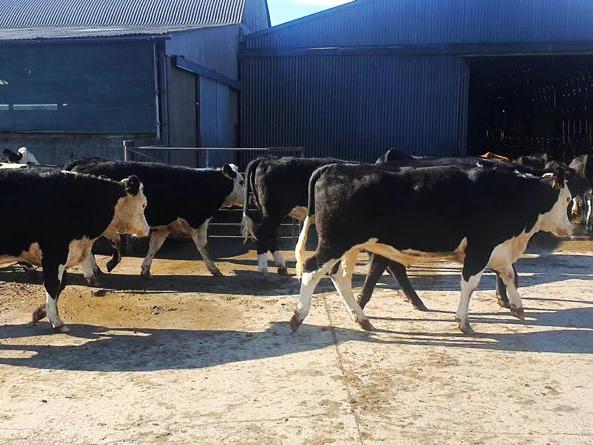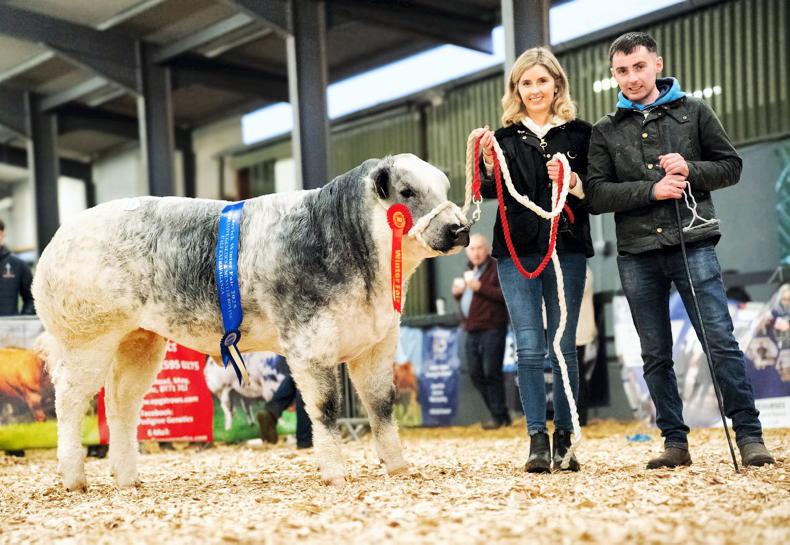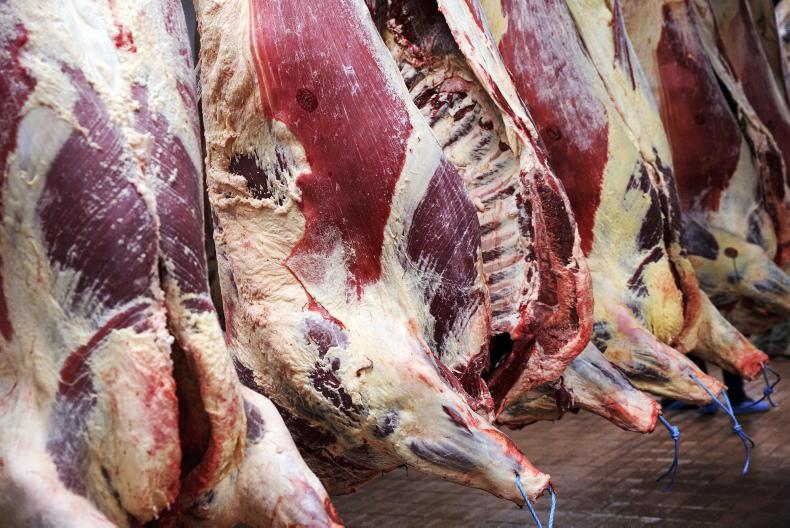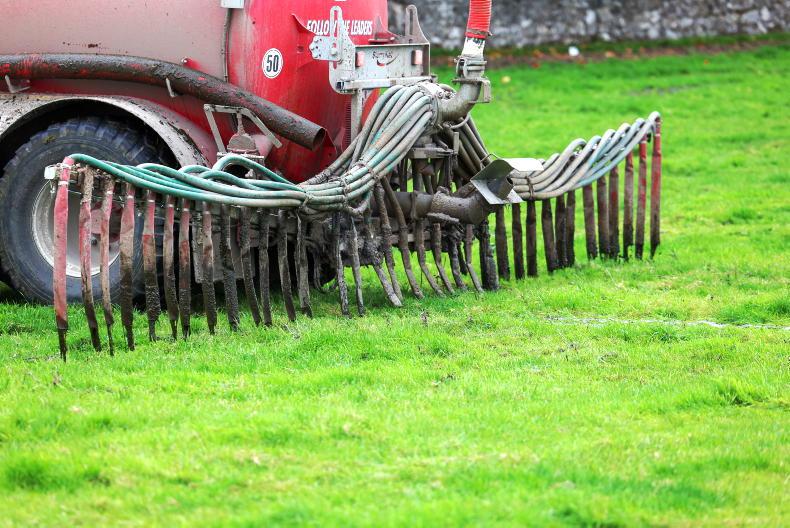In dairy calf-to-beef systems, many farmers will have chosen a production system from the outset and will be continually working towards the target finishing date.
For spring 2019-born calves, this may be off grass this autumn at between 19 and 21 months or out of the shed next spring at 24 months. Whichever endpoint has been chosen, it is important that animals are continually hitting targets throughout the system.
Many of the Thrive programme farms are operating a 19- to 21-month system with the aim of eliminating the expensive second winter period. This system also suits where winter accommodation is limiting, as there is only ever one crop of calves housed for winter.
On these farms, the finishing phase has commenced in the last week or two with many of the farms beginning to introduce meal feeding at grass. With grazing conditions deteriorating over the last couple of weeks, many farmers will be considering introducing concentrates to animals to maintain performance.
What animals to feed?
Before any meal feeding is introduced, it is important to know what weight the animals are. Within every batch of cattle there will be a spread of birth dates, genetic potential and, ultimately, liveweight.
Weigh every animal and split into two groups – one for concentrate feeding now and one to remain on grass only for the moment.
Meal feeding should only be introduced to finishing stock that are within 50kg to 60kg of the point of slaughter – roughly six to eight weeks’ feeding.

Bullocks on the Thrive demonstration farm heading back to grass after meal feeding in the shed.
There is no point in starting to feed cattle that are going to be too light to slaughter in this time frame.
In most cases, the programme farms are using traditional breeds that, if fed, will start to lay down significant levels of fat and there is a good chance they will go out of spec from a carcase fat score point of view or will end up being slaughtered at a very low carcase weight.
Therefore, heifers less than 460kg liveweight and bullocks less than 480kg liveweight should not be fed meal at this stage.
Where animals are close to this weight and performance at grass is good, then meal could be introduced in the coming weeks.
If animals are well below this weight, then a housing period is going to be needed prior to slaughter.
Consistency key in feeding system
With ground conditions becoming an issue in many areas of the country, some farms may have to consider housing finishing animals in the coming days.
Taking heavier animals off the land makes sense, as they will do the most damage. By doing so, you should extend the grazing period further into autumn for this year’s calves.
While this decision will vary from farm to farm, if animals close to finishing are housed, it would be best that they remain housed through to slaughter, even if the weather was to pick up once again.
Consistency is king in finishing systems
Turning them out to grass again in a week to 10 days will only delay slaughter date as they take time to adjust to the changing diet.
Consistency is king in finishing systems. Keeping diets consistent will maximise liveweight gain. If you are feeding meal once a day, make sure you do it at the same time every day. Animals like a routine.
If you feed before work at 8am this morning, they will be expecting their meal at 8am again tomorrow morning – don’t leave it until after work to feed them tomorrow.
Where conditions allow cattle to remain at grass, feeding meal may still cause poaching issues. Make best use of farm roadways, where they are available for feeding animals.
Take care when feeding meal at grass. Animals will push and shove to get to the feeder, especially in periods of poor weather
If cattle are grazing close to the farmyard, it may make more sense to run them in for feeding.
Where trough feeding has to take place in paddocks, choose the driest part of the field and move troughs daily to avoid doing serious damage.
Take care when feeding meal at grass. Animals will push and shove to get to the feeder, especially in periods of poor weather.
Keep cattle behind an electric fence and only let them to the trough once you have it filled and are out of harm’s way.
Grass management
Grass management should not be forgotten just because meal is being fed. Try to move stock to new grass every two to three days or at least twice a week.

Good grass management is just as important as meal feeding in the finishing phase.
Meal feeding rates outlined in this article are assuming good levels of grassland management.
Where grass quality is consistently poor in front of stock, meal feeding levels would nearly need to be doubled which becomes economically unviable.
What ration and how much to feed?
When feeding finishing animals at pasture, the first limiting factor from grass in autumn is energy. Look for a ration with a UFV value of greater than 0.95 UFV/kg. Look for rations with a high inclusion rate of rolled barley or maize meal.
Protein levels in grass will be sufficient to meet the requirements of a finishing animal. A 12% to 14% ration is more than adequate in this case. Some farmers will be using rations with as little as 11% protein when feeding at grass. There is no point feeding excess protein in the diet of a finishing animal, as it will pass straight through the animal and there is actually an energy cost associated with processing excess protein in the body.
Finishing rations are typically trading at around €250/t €260/t at the moment – add €40/t if bagged. Other important factors to consider are the inclusion of yeast or acid buff to aid digestion and a good mineral spec that will provide around 400mg/day to the animal at the given feeding rate.
Once you are feeding at least 4kg concentrate each day, it is important to split it into two feeds, morning and evening, to avoid causing stomach upsets such as acidosis
Introduce concentrate at a rate of 2kg/day. This can be increased slowly over the first week by 0.5kg every second day. For early-maturing breeds such as Angus and Hereford, offering 2kg to 3kg/day is sufficient, especially for heifers. Where late-maturing breeds such as Belgian Blue and Limousin are being used, this can be increased to 3.5kg/day or even 4.5kg/day for steers.
Once you are feeding at least 4kg concentrate each day, it is important to split it into two feeds, morning and evening, to avoid causing stomach upsets such as acidosis.
Farmers feeding meal at these rates will see a good response in terms of animal liveweight gain. It will also improve kill-out percentage and could push the animal up a grade for conformation.
Drafting for slaughter
It is important to keep an eye on the fat cover of finishing animals, as some types will lay down fat quite quickly once on hard feed. Weigh cattle once they are on feed for three to four weeks and assess body condition. It’s better to draft a smaller number every couple of weeks than to wait to send all to the factory the one day. Drafting animals while they are still in-spec will more than pay for the extra trip to the factory.
In dairy calf-to-beef systems, many farmers will have chosen a production system from the outset and will be continually working towards the target finishing date.
For spring 2019-born calves, this may be off grass this autumn at between 19 and 21 months or out of the shed next spring at 24 months. Whichever endpoint has been chosen, it is important that animals are continually hitting targets throughout the system.
Many of the Thrive programme farms are operating a 19- to 21-month system with the aim of eliminating the expensive second winter period. This system also suits where winter accommodation is limiting, as there is only ever one crop of calves housed for winter.
On these farms, the finishing phase has commenced in the last week or two with many of the farms beginning to introduce meal feeding at grass. With grazing conditions deteriorating over the last couple of weeks, many farmers will be considering introducing concentrates to animals to maintain performance.
What animals to feed?
Before any meal feeding is introduced, it is important to know what weight the animals are. Within every batch of cattle there will be a spread of birth dates, genetic potential and, ultimately, liveweight.
Weigh every animal and split into two groups – one for concentrate feeding now and one to remain on grass only for the moment.
Meal feeding should only be introduced to finishing stock that are within 50kg to 60kg of the point of slaughter – roughly six to eight weeks’ feeding.

Bullocks on the Thrive demonstration farm heading back to grass after meal feeding in the shed.
There is no point in starting to feed cattle that are going to be too light to slaughter in this time frame.
In most cases, the programme farms are using traditional breeds that, if fed, will start to lay down significant levels of fat and there is a good chance they will go out of spec from a carcase fat score point of view or will end up being slaughtered at a very low carcase weight.
Therefore, heifers less than 460kg liveweight and bullocks less than 480kg liveweight should not be fed meal at this stage.
Where animals are close to this weight and performance at grass is good, then meal could be introduced in the coming weeks.
If animals are well below this weight, then a housing period is going to be needed prior to slaughter.
Consistency key in feeding system
With ground conditions becoming an issue in many areas of the country, some farms may have to consider housing finishing animals in the coming days.
Taking heavier animals off the land makes sense, as they will do the most damage. By doing so, you should extend the grazing period further into autumn for this year’s calves.
While this decision will vary from farm to farm, if animals close to finishing are housed, it would be best that they remain housed through to slaughter, even if the weather was to pick up once again.
Consistency is king in finishing systems
Turning them out to grass again in a week to 10 days will only delay slaughter date as they take time to adjust to the changing diet.
Consistency is king in finishing systems. Keeping diets consistent will maximise liveweight gain. If you are feeding meal once a day, make sure you do it at the same time every day. Animals like a routine.
If you feed before work at 8am this morning, they will be expecting their meal at 8am again tomorrow morning – don’t leave it until after work to feed them tomorrow.
Where conditions allow cattle to remain at grass, feeding meal may still cause poaching issues. Make best use of farm roadways, where they are available for feeding animals.
Take care when feeding meal at grass. Animals will push and shove to get to the feeder, especially in periods of poor weather
If cattle are grazing close to the farmyard, it may make more sense to run them in for feeding.
Where trough feeding has to take place in paddocks, choose the driest part of the field and move troughs daily to avoid doing serious damage.
Take care when feeding meal at grass. Animals will push and shove to get to the feeder, especially in periods of poor weather.
Keep cattle behind an electric fence and only let them to the trough once you have it filled and are out of harm’s way.
Grass management
Grass management should not be forgotten just because meal is being fed. Try to move stock to new grass every two to three days or at least twice a week.

Good grass management is just as important as meal feeding in the finishing phase.
Meal feeding rates outlined in this article are assuming good levels of grassland management.
Where grass quality is consistently poor in front of stock, meal feeding levels would nearly need to be doubled which becomes economically unviable.
What ration and how much to feed?
When feeding finishing animals at pasture, the first limiting factor from grass in autumn is energy. Look for a ration with a UFV value of greater than 0.95 UFV/kg. Look for rations with a high inclusion rate of rolled barley or maize meal.
Protein levels in grass will be sufficient to meet the requirements of a finishing animal. A 12% to 14% ration is more than adequate in this case. Some farmers will be using rations with as little as 11% protein when feeding at grass. There is no point feeding excess protein in the diet of a finishing animal, as it will pass straight through the animal and there is actually an energy cost associated with processing excess protein in the body.
Finishing rations are typically trading at around €250/t €260/t at the moment – add €40/t if bagged. Other important factors to consider are the inclusion of yeast or acid buff to aid digestion and a good mineral spec that will provide around 400mg/day to the animal at the given feeding rate.
Once you are feeding at least 4kg concentrate each day, it is important to split it into two feeds, morning and evening, to avoid causing stomach upsets such as acidosis
Introduce concentrate at a rate of 2kg/day. This can be increased slowly over the first week by 0.5kg every second day. For early-maturing breeds such as Angus and Hereford, offering 2kg to 3kg/day is sufficient, especially for heifers. Where late-maturing breeds such as Belgian Blue and Limousin are being used, this can be increased to 3.5kg/day or even 4.5kg/day for steers.
Once you are feeding at least 4kg concentrate each day, it is important to split it into two feeds, morning and evening, to avoid causing stomach upsets such as acidosis.
Farmers feeding meal at these rates will see a good response in terms of animal liveweight gain. It will also improve kill-out percentage and could push the animal up a grade for conformation.
Drafting for slaughter
It is important to keep an eye on the fat cover of finishing animals, as some types will lay down fat quite quickly once on hard feed. Weigh cattle once they are on feed for three to four weeks and assess body condition. It’s better to draft a smaller number every couple of weeks than to wait to send all to the factory the one day. Drafting animals while they are still in-spec will more than pay for the extra trip to the factory.












SHARING OPTIONS